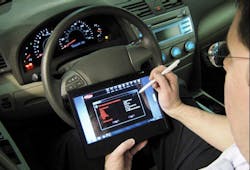Delphi Auto IQ Scan and Flash Tool Advanced Tech Tips: CAN Bus Diagnostics
Diagnosing serial bus circuits such as the latest CAN bus systems can be challenging to say the least. Knowing your way around a DMM (meter) and DSO (scope) is essential but knowing how to get the most from your scan tool and reprogramming tools are equally essential.
Using the Delphi scan & flash tool on a vehicle with a serial bus communications problem can be advantageous for a variety of reasons. The first real world diagnostic benefit with the Delphi Electronics / Delphi SAE compliant J2534 pass-thru device allows for a quick assessment of what modules are answering on the bus during the whole vehicle bus check. As professional automotive techs, we have to think like a good physician that takes into consideration the entire body and not just one subsystem. Using this analogy we can conclude that even if warning indicator for the stability system is on, for example, we should look at all trouble codes in all modules.
Occasionally the root of one system’s problem lies in an entirely different system. For the doctor and patient this means a compressed disc in the patient’s back can cause a pinched nerve that results in a pain in their foot. For the technician and vehicle owner this analogy might be played out with the Stability Control System’s warning light illuminating courtesy of the ABS module simply because a lean condition is brewing in the PCM. The MIL may not even be illuminated yet if the problem is a pending code at the moment, but the stability control system (ABS) can’t rely on the engine management system (PCM) to do torque management via throttle by wire if it can’t trust that PCM to have all of its ‘ducks in a row.'
After vehicle connection
After a the entire vehicle has been scanned for DTCs (not just the system your customer is complaining about) if there are module not communicating with the Delphi tool it will be for one of two reasons – the module is unable to communicate due to problems with power, ground, bus connections or the module itself is faulty or that particular module is not an option on that vehicle. Some factory scan tools know via the VIN which modules the vehicle has been built with and which don’t. Most scan tools, however, go ahead and do the diagnostic circuit ‘roll call’ whether that vehicle has that option or not.
So if you run a total vehicle diagnostic DTC Health Check while watching the list of modules pop up with a DTC listed in red or the word “OK” in green don’t forget to look for the smaller font in white on your screen (see Fig. 2). These lines pop up displaying “trying to communicate” with module XYZ.
If that particular module isn’t communicating due to a problem, or the simple fact the Chevy you’re scanning doesn’t have that module as an option (i.e. OnStar), the smaller white font lines that tell you what the scanner is doing at that very instant will report “module XYZ failed communications.” If that module is not applicable (i.e. your customer’s vehicle doesn’t have OnStar) you simply ignore that brief message in the ‘fine print.’ But if your vehicle is indeed equipped with ABS, for example, and you see the tool trying to communicate and then giving up you won’t see any DTCs pop up in the larger font area in red. You may, however, see some other modules such as the PCM reporting U-codes for being unable to communicate with the ABS module that either can’t (bad power, ground or bus wiring) or won’t (faulty module) communicate on the serial bus.
Bus topology
Another advanced feature of the Delphi Scan / Flash tool is performed on select vehicles when you have a software update (flash) subscription for that OEM. For example, you have a subscription to Chrysler’s Tech Authority which allows you to flash powertrain related Chrysler / Dodge /Jeep modules as well as peruse the factory service manual.
Even if you don’t have a reason to reflash the PCM you can still connect the Delphi tool and select “I-Flash” which not only allow you to reflash that PCM if you wanted to but also gives you a little utility feature that the Chrysler factory WiTech tool contains to get the big picture on the serial bus status. This feature, called “Bus Topology” shows all the various speeds of CAN buses, the name of the gateway module and the status of each module (see Fig. 3). Color coding allows you to see which modules are supposed to be on that vehicle but aren’t communicating and which modules are simply an option that your customer’s vehicle didn’t’ come equipped with.
Toyota/Lexus
Another OEM that allows advanced diagnostics with a J2534 tool is Toyota / Lexus. When you have a professional level subscription to Toyota TIS, you can peruse factory service info, view new model training information, reflash modules and run the Toyota Techstream factory scan tool software on your laptop using the Delphi J2534 scan / flash tool as the pass-thru device (see Fig. 4). This allows you to scan any and all modules at the exact level dealers do (including relearns and option configurations) and flash as easy as the Toyota dealer can. The CAN bus diagnostic feature built into Toyota Techstream is very useful in determining the root causes of communication problems.
Anyone can download the Techstream software from Toyota’s TIS website (for free) but when you click on the upper left hand corner icon labeled “Connect to Vehicle” you’ll be prompted to get a Toyota TIS professional level subscription in order to generate a license code that will allow you to scan, do bi-directional command, relearn and reconfigure and of course reprogram modules on Toyota and Lexus (see Fig. 5).
